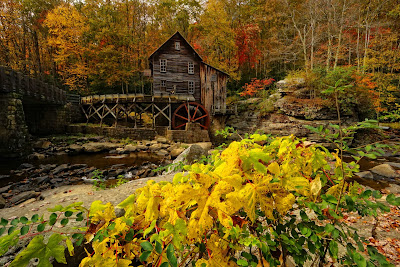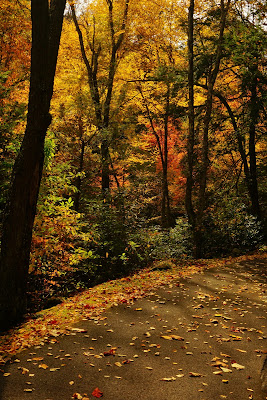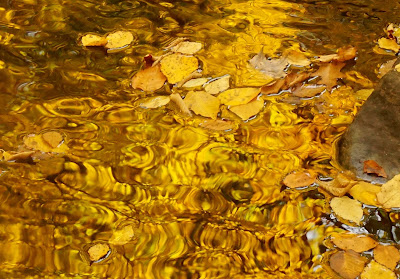Seven Ways to Capture Brilliant Color in Fall Photography
How do you get good autumn photographs even if the fall foliage lacks brilliance? I was asking this question all day at one of my (and everyone else�s) favorite places to shoot fall photographs�Babcock State Park, Fayette County, WV. Due to an extremely hot and dry summer, the leaf color change has been muted somewhat and delayed by about a week. Even so, here are seven ways to photograph fall scenes to bring out the very best in autumn color.
All of the examples in this post were taken on the same day at Babcock. Despite less than peak conditions, I enjoyed roaming the park and applying the seven tips I�ve included here. Autumn is a wonderful time to be a photographer. I hope these tips help you savor it.
 |
| Bright Foreground |
Bright Foreground
One way to spruce up the color is to include bright foreground foliage. An overhanging branch or a small shrub work well in this instance. As a bonus, these foreground elements add depth to the work and can act as natural frames. |
| Back-lighting |
Use Back Light
Nothing lights up leaves like back-lighting, which is simply having the prime light source behind or in back of the subject. In outdoor photography, the sun is the primary light source, so to get autumn leaves to shine for you simply align the fall foliage between you and the sun. This technique brings out rich color even in leaves that are dull or past prime. |
| Underexpose |
Underexpose the Image
Overexposures wash out color. So it stands to reason that to boost color saturation, underexposure is called for. Depending upon the intensity of the light, I will adjust the EV (Exposure Value) down by 1/3 to 1 to get the richest color. Decreasing the EV also makes sunlit leaves stand out by darkening the areas surrounding them. |
| Adjust White Balance |
Adjust White Balance
White balance settings on your camera compensate for the kind of light illuminating the scene you are shooting. As evidenced by the color of the sky, a sunny day sheds a lot of blue light. If your photographs have a blue cast to them or if colors look duller than you remember them, experiment with white balance. To get deeper reds and yellows, I generally set my white balance to shade or cloudy if I�m not shooting in raw format. |
| Take Close-ups |
Take Close-ups/Isolations
Even if leaf color is subdued, there are always bright trees among the dull ones. Isolating the leaves of a colorful tree with a close-up will often produce a compelling fall photograph. Tight close-ups can make an abstract image out of the leaves adding to the artistry of fall photography. |
| Look for Reflections |
Look for Reflections
Reflections darken and enrich colors. So I am always looking for ways to catch the color of autumn leaves bouncing off the surface of lakes and streams. It�s fun to study a stream, locate the colorful leaves, and work out the angles to catch the colors in a reflection. And the results can be very satisfying. Just like isolating leaves, close-ups of reflections can produce stunning abstract images. |
| Find Fallen Leaves |
Find Fallen Leaves
Even if the leaves on the trees lack brilliance, you can always add dashes of color and interest to a fall image by photographing fallen leaves. Fallen leaves often gather in clusters that form a tapestry of color. Photographing leaves on wet rocks add color and foreground interest. In addition, fallen leaves also tell a story of the changing of the season.All of the examples in this post were taken on the same day at Babcock. Despite less than peak conditions, I enjoyed roaming the park and applying the seven tips I�ve included here. Autumn is a wonderful time to be a photographer. I hope these tips help you savor it.



Comments
Post a Comment